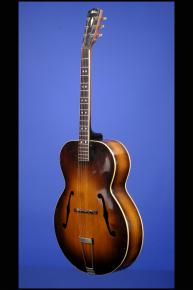Gibson's Rarest 17-Inch Archtop
This 17-inch-wide acoustic archtop weighs just 4.60 lbs. and has a very fat nut width of just under 1 3/4 inches and a standard Gibson scale length of 24 3/4 inches. Hand-carved bookmatched solid spruce top, two-piece curly maple back, maple sides, one-piece mahogany neck with a wonderfully thick profile, and rosewood fretboard with 19 frets and inlaid 'double-arrow' position markers. Headstock with inlaid Pearl "Gibson" logo and pearl diamond inlay. Single binding on the top and the back, single-bound fretboard. Kluson strip tuners with oval sandstone buttons. Frequensated rosewood bridge on rosewood base and trapeze tailpiece with four vertical lines on cross-bar. This guitar is in excellent plus (8.75) condition. Later tortoiseshell over three layer white/black/white pickguard. There is some miniscule belt buckle wear on the back of the guitar, a few marks on the sides and the top, a small amount of fretwear, but the frets have plenty of life left in them. The action on this guitar is nice and low -- it has never had nor needed a neck reset. Later Gibson black hardshell case with purple plush lining (9.00).
This is a transition model which has the 17 inch width of the 1935-39 model, but without the X-braced top and the checkered top binding that was introduced in 1935. It has the inlaid pearl diamond on the headstock which replaced the 'vase and culicues', and also the 'flat plate' tailpiece with cutouts which was introduced in 1936.
"The L-10 was the second of Gibson's f-hole archtop models, introduced in 1931. Originally it was a rather plain guitar, with black finish and dot inlay. With the introduction of the L-12 in 1934, the L-10 adopted the fancy ornamentation of the L-12 but kept the black finish and nickel-plated metal parts. Later in 1934, with the increase in body sizes, the L-10 took on a dramatic new look, with bullet-shaped fingerboard inlays, a vase with curlicues on the peghead (replaced by the diamond a year later), checkered top binding, and a reddish sunburst top finish. While the models below and above it prospered, the L-10 did not. It was discontinued by 1939" (George Gruhn and Walter Carter, Acoustic Guitars and Other Fretted Instruments: A Photographic History, p. 172).
Translate:








